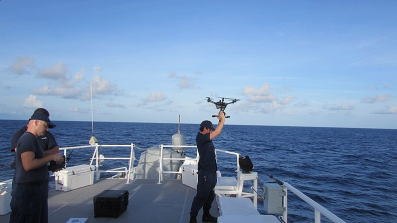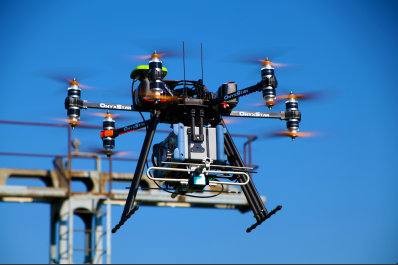Flying Robots and Swimming Robots: drones and AUVs
- UFRJ Nautilus
- May 19, 2021
- 5 min read
Updated: May 12, 2022
One of the new goals of the Nautilus team is to diversify our areas of operation. To this end, we have recently started to develop autonomous aerial vehicles, and in the course of this article we will explain how this new class of vehicle differs and how it resembles the AUVs that are the focus of the team.
Very briefly, let's recap the definition of an AUV.
An Autonomous Underwater Vehicle is simply an autonomous vehicle, which operates in a specific medium, below the surface of the water. Essentially it would not be wrong to think of an AUV as a "submarine drone", but it is against the common use of the terms.
As a technical term for drone, we have a very similar acronym that can cause confusion, UAV, which means Unmanned Aerial Vehicle, or in Portuguese VANT (Unmanned Aerial Vehicle).
Many other acronyms such as ROV, UAS, VAS and RPA are related to this subject, but we will only use the terms drone and AUV to avoid confusion.
History
The drone has grown tremendously in the past decade, it is hard to have never seen one flying at any sporting event, or just flying as a hobby. These most common drones are a specific type called a multicopter, so called because they have multiple engines, which are their only form of propulsion and flight control.
The cheapening of electronic control technologies, accelerometers and pressure sensors has allowed quadcopters to take off as seen from 2010 until now. Today it is possible to find several relatively inexpensive models on the internet and even in malls. But how exactly do they work?

Feature
Just like the AUV, the drone is usually an electric vehicle and therefore relies on a battery as a source of energy. This battery is usually of the Lipo type (Polymer of lithium) and for the need to be of high capacity, it consists of much of the weight of the drone. This is the main factor that limits the flight range of a drone.
Multicopters can not glide like airplanes or float like AUVs, so every flight time and every maneuver depends on the constant action of the engines. The result of this is a huge expenditure of energy that strongly limits the flight time and the maximum weight of the cargo.
Worse still, it is not possible to just place larger batteries, as any additional weight is more energy used to lift and maintain flight. So for a drone it is very important to use lightweight materials in its construction. It is very common to see the use of plastics, carbon fiber, and when it is necessary to use metal, aluminum.
This made it impossible for many years to develop flying electric vehicles, however, when high density batteries arrived on the market, the drone established itself as an extremely valuable tool for professionals in the most diverse areas, as will be seen below.
AUVs and drones have very similar control systems, but they operate quite differently.
Both have some type of controller that will receive information from the sensors, make decisions and send commands to start the motors. In addition, this controller may or may not transmit data to an external station. In the case of AUVs and Nautilus drones, this external communication always occurs.
Because of the difference in the environment, the activation of the engines is quite different between these two. The AUV has motors associated with axes of movement, and when driving one of these, the AUV moves on that axis. Meanwhile, the drone increases or decreases the speed of groups of engines to move. It is easier to understand by looking at the diagram below:

Here we see a drone seen from top to bottom. If this drone wants to move to a higher altitude, it will increase the speed of all engines, and the reverse if it wants to go down. To go to the right, the rotation of engines A and C will increase as they are on the left side of the drone, this causes the left side to rise in relation to the right, thus forcing the drone to move.
It is also possible to see that there are a pair of motors rotating clockwise and an anti-clockwise pair. If they all rotated in the same direction, the entire drone would rotate in the opposite direction because of inertia. When the drone needs to rotate without moving, it varies the speed of one of these pairs, for example, it increases the speed of the BC pair to rotate clockwise. The explanation above is a huge simplification of reality. To maintain a stable flight even in windy conditions, it is necessary for the on-board system to perform thousands of calculations per second, and small adjustments to the engines constantly.

Applications
All this advancement and sophistication allow drones to be versatile aerial platforms for all types of work. Much cheaper and more practical than helicopters and much more versatile than cranes. Today drones are the best option when it comes to aerial photography. But new areas are rapidly adopting these technologies, in several cases in conjunction with AUVs. Today we already see big names like Embraer talking about developing drones capable of transporting people between points in a city. We see Amazon and Pizza hut already using drones in their express deliveries.
We can only use it like that because of the integration of drones with GPS systems. Having a precise location in real time, the on-board computer is able to follow an exact flight plan and thus be much more useful. It also opens up the possibility of carrying out much more complex tasks, today the mapping of rural or forest areas is already done automatically and drones already do logistics work in warehouses. But undoubtedly one of the applications that will be most implemented in the future is the inspection drone. Today the AUVs are already doing the work of divers by performing some underwater inspections. The drone stands out as a future substitute for the worker who ventures to look for flaws in storage tanks, oil platforms and ships.
Using high-resolution cameras and infrared sensors, the drone can save people the risk of being in tall structures just for quick inspection. Likewise, AUVs replace divers who often die in operations that could be automated, such as simple maintenance on platforms and undersea cables. This application increases the quality of the work done, as it makes it easier to carry out more inspections, and provides security for professionals who are constantly taking risks. For companies, it can be huge cost cuts with structural failures being identified earlier, saving expensive equipment.
Even more effective, drones and AUVs can operate completely autonomously, allowing several units to alternate work constantly without the need for operators, who need rest and make more mistakes. The use of sophisticated algorithms and machine learning can also identify flaws that human operators would never be able to find because they are very subtle. In summary, drones and AUVs can be the biggest cost-cutting and security enhancement tool for the oil, port, cargo transportation, and more industries. We will certainly see many new applications in the coming years that will give better results and make life easier for everyone.

Written by Augusto Lauande

Comments